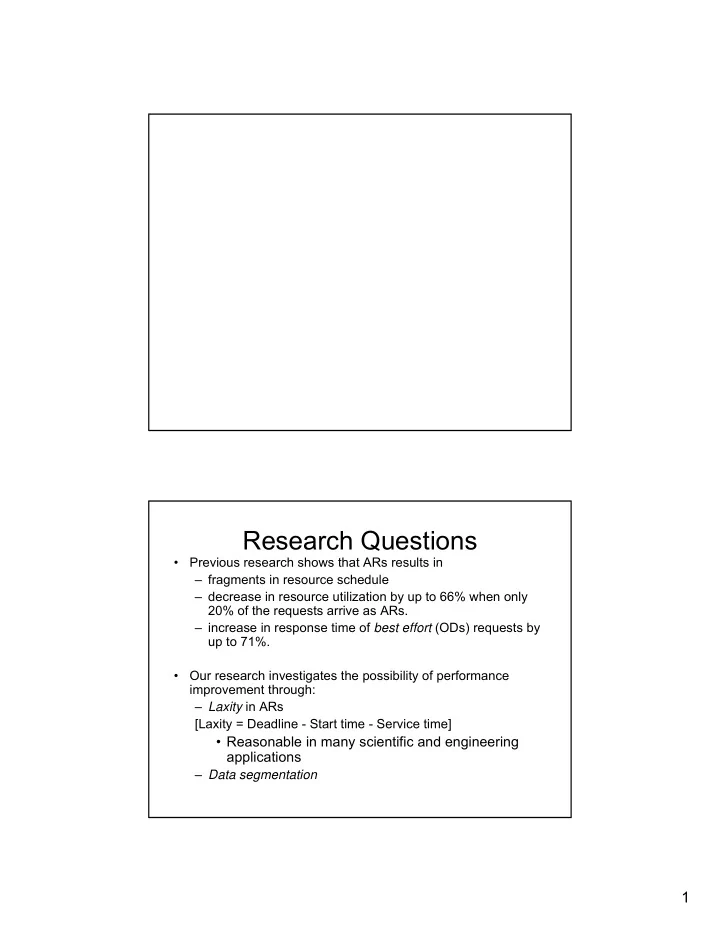

Research Questions • Previous research shows that ARs results in – fragments in resource schedule – decrease in resource utilization by up to 66% when only 20% of the requests arrive as ARs. – increase in response time of best effort (ODs) requests by up to 71%. • Our research investigates the possibility of performance improvement through: – Laxity in ARs [Laxity = Deadline - Start time - Service time] • Reasonable in many scientific and engineering applications – Data segmentation 1
Scheduling Problem Definition • Scheduling Algorithm triggered on request (task) arrival • Given a set of tasks {i, j, …, k} and sets of start times {t i , t j , …, t k }, service times {e ib , e jb , …, e kb } and deadlines {d i , d j , …, d k }, generate a schedule such that each task i starts executing after its start time t i and finishes before its deadline d i . • On-Demand Requests: – Very Large Deadline • Our algorithm is inspired by existing work in real time scheduling – Needs to handle variable number of requests (open arrival) – Handles both preemptive (data segmentation) and non- preemptive (no data segmentation) systems SSS Algorithm – a High Level Description • Basic Idea: Scaling through Subset Scheduling – Whenever a new request arrives, the SSS algorithm first finds all those tasks in the resource schedule that can affect the feasibility of the new schedule with the new request and then tries to work out a feasible schedule for only that subset of tasks S. • Step 1 : Obtain S – Set of all those tasks that can affect the scheduled-time of the new task and whose scheduled-time can be affected by the new task. • Step 2 : Obtain an initial solution for tasks in S using the modified Earliest-Deadline-First Strategy that accounts for both preemptable and non-preemptable tasks. • Step 3 : If the solution is feasible, accept the task and update resource schedule. Otherwise, calculate lower bounds on the lateness of the critical task and see if its lateness can be improved. If it cannot be improved reject the new task. Otherwise, go to step 4. • Step 4 : Improve on the initial solution iteratively using pruned branch and bound technique 2
Effect of Laxity and Data Segmentation on Performance • Simulation-Based investigation • Performance Metrics – Probability of Blocking P b – Resource Utilization U – Response Time of ODs R OD – Response Time of ARs R AR • Workload Parameters – Service Time of Tasks (Mean and Distribution) – Arrival Rate (Poisson arrival process) – Time between the arrival of an AR and its Start Time – Proportion of Advance Reservations (PAR) – Mean Percentage Laxity (L) Impact of Laxity 0.45 • For a given L, P b increases 0.4 with PAR. 0.35 0.3 0% L 20% L 0.25 60% L • As L increases, P b b 100% L P 0.2 150% L decreases substantially. 200% L 500% L 0.15 – The effect becomes more 0.1 pronounced with the increase 0.05 in PAR. Thus for 80% 0 requests arriving as ARs, L = 0 0.2 0.4 0.6 0.8 1 PAR 200% can decrease Pb by 0.45 more than a factor of 3 0.4 (compared to the case in 0.35 which ARs have no laxity). 0.3 – Knee of graph: PAR = 0 PAR = 0.2 0.25 PAR = 0.4 b Diminishing returns if L P PAR = 0.6 0.2 PAR = 0.8 is increased beyond the PAR = 1 0.15 knee 0.1 0.05 0 0% 100% 200% 300% 400% 500% L 3
Impact of Laxity 0.7 0.6 • Utilization: similar behaviour 0.5 0% L as P b 20% L 0.4 60% L – U = λ *(1 – Pb)*(R – U 100% L 150% L 0.3 W) 200% L 500% L 0.2 0.1 0 0 0.2 0.4 0.6 0.8 1 PAR 260 240 • Response Time of ODs 220 – Non-Monotonic behavior for 0% L R OD (minutes) 200 20% L lower L values. 60% L 180 100% L 150% L – Starvation of ODs 200% L 160 500% L • Prevention 140 120 100 0 0.2 0.4 0.6 0.8 1 PAR Summary of Observations • SSS can effectively handle ARs + ODs on a Grid. • Can be adapted to Clouds • Laxity in the reservation window can significantly improve system performance by reducing probability of blocking and increasing utilization. – The effect is more pronounced for the cases where proportion of advance reservations is high. • Data segmentation can also improve system performance: – Depends on the distribution of service times. – More improvement in U and R OD with high variance in service times. • The results also show that the improvement in performance with segmentation is sensitive to L. At higher L values, difference in utilization diminishes. This suggests that laxity can be exchanged for data segmentation to achieve high utilization of lightpaths. 4
Recommend
More recommend